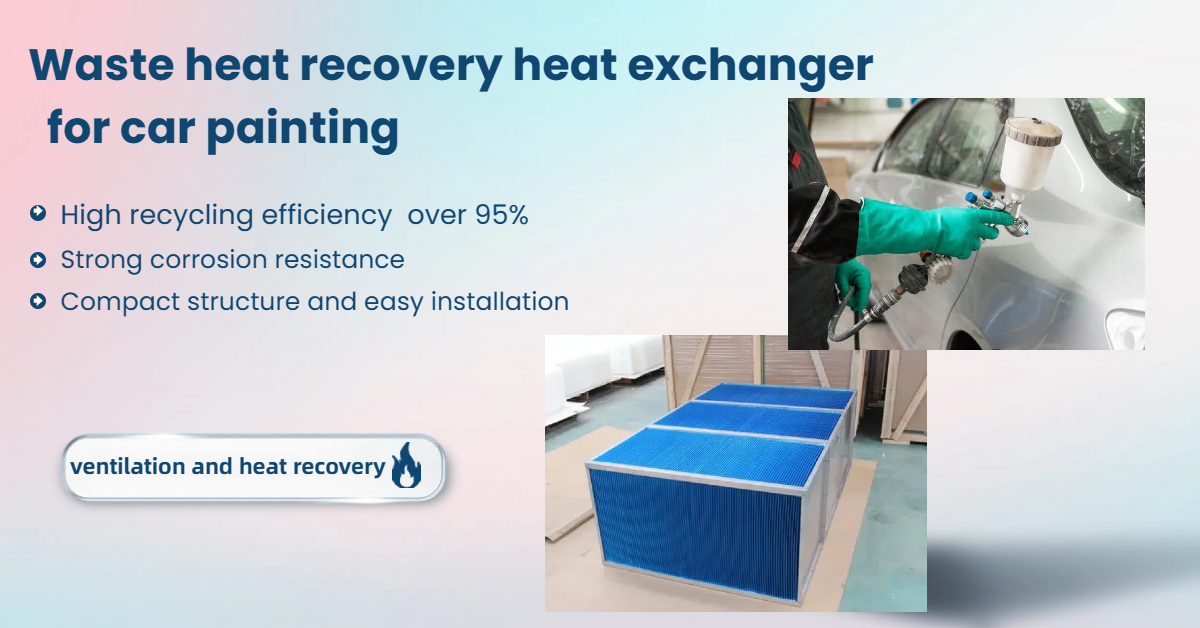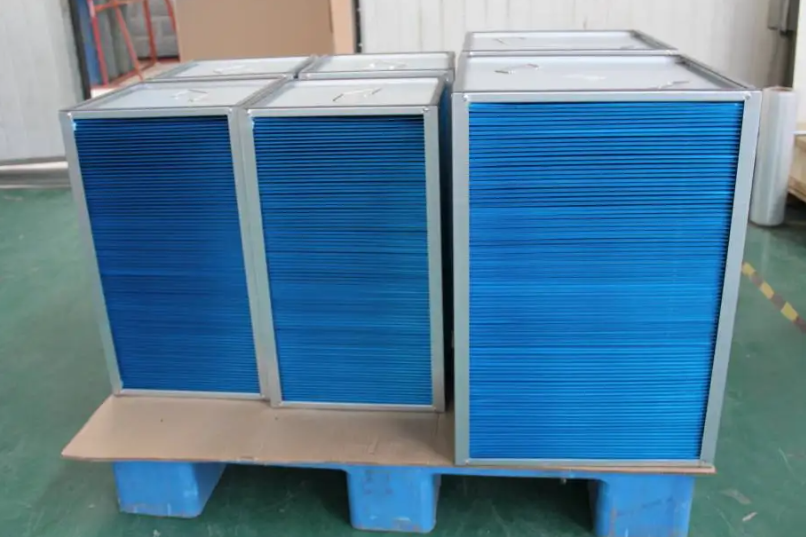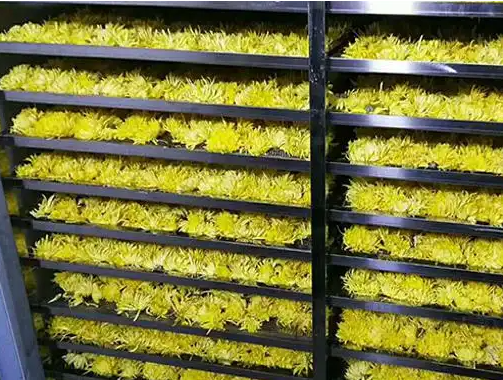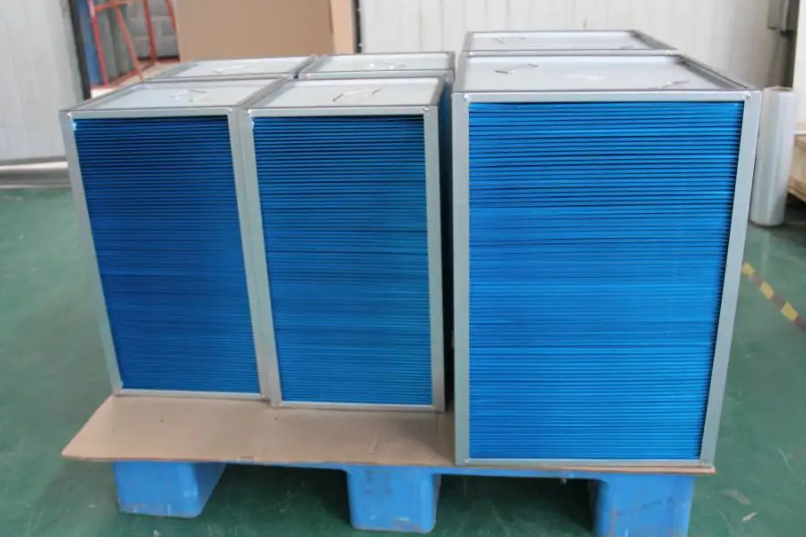The total heat exchanger of the fresh air ventilation fan in underground parking lots is a key equipment used to improve the air quality of underground parking lots. It plays an important role in improving the air quality of underground parking lots, ensuring the health of personnel, and saving energy.
working principle
Underground parking lot fresh air centrifugal duct fans and total heat exchangers are usually used in combination to achieve efficient air exchange and temperature control.
The fresh air system introduces fresh outdoor air into the underground parking lot through pipelines, while also expelling polluted indoor air. The total heat exchanger exchanges heat between the fresh air and the exhaust air, recovers the heat from the exhaust air, and uses it to preheat or pre cool the fresh air, thereby improving energy utilization efficiency.
Functional Features
Efficient ventilation: It can quickly and effectively update the air in underground parking lots and maintain indoor air quality.
Energy saving and consumption reducing: The total heat exchanger reduces the energy consumption required for fresh air treatment and lowers operating costs by recovering heat from exhaust air.
High air volume design: Suitable for the large space and high air volume requirements of underground parking lots, ensuring effective air circulation.
अनुप्रयोग परिदृश्य
Underground parking lot: mainly used for ventilation and temperature control in multi-level underground parking lots.
Other enclosed spaces: also applicable to other enclosed spaces that require efficient ventilation and energy conservation, such as shopping malls, hotels, offices, etc.
Total Heat Exchanger for Underground Parking Lots Ventilation
Heat exchanger heat recovery equipment for drying chrysanthemums and honeysuckle
working principle:
During the drying process of chrysanthemums and honeysuckle, the high-temperature moisture (exhaust) generated is transferred to the fresh air entering the system through the heat exchange core. In this way, the fresh air is preheated before entering the drying area, thereby reducing the energy consumption required to heat the fresh air.
Structural features:
High quality hydrophilic aluminum foil is usually used as a heat transfer conductor, which has good heat transfer efficiency and a long service life (generally up to 8-10 years)
The channels for fresh air and exhaust air are arranged in a cross pattern, separated by aluminum foil to ensure the cleanliness of the fresh air and avoid the transmission of any odors and moisture.
All connections are sealed with sealant and treated with biting edge flow adhesive to ensure the airtightness of the heat exchanger.
Performance advantages:
The heat exchange efficiency is as high as 90%, which can significantly reduce energy consumption.
Compact structure, small volume, suitable for installation and use in various occasions.
Easy to maintain, easy to clean, can be directly cleaned with tap water or neutral detergent.
Waste heat recovery plate heat exchanger for grain drying
Grain drying is an important step in ensuring safe storage and reducing losses, and the drying heat exchanger plays a crucial role in this process. The grain drying heat exchanger can quickly complete the grain drying process and improve production efficiency through an efficient heat transfer mechanism. Meanwhile, adopting waste heat recovery technology can significantly reduce energy consumption, lower production costs, and reduce carbon emissions, which contributes to environmental protection.
structure type
Tube and tube heat exchanger: Tube and tube heat exchangers, also known as shell and tube heat exchangers, have a simple structure, low manufacturing difficulty, and are easy to clean and maintain. During the process of grain drying, high-temperature flue gas generated by burning coal or other fuels is used as the heat medium.
Plate heat exchanger: Plate heat exchangers are widely used in grain drying due to their simple structure and low manufacturing cost.
working principle
Waste heat recovery: During the drying process of grain, a large amount of heat is generated. The waste heat recovery system improves energy efficiency by collecting this waste heat and transferring it to new dry air.
Preheating air: Some advanced grain drying systems utilize waste heat recovery technology to preheat fresh air, further improving drying efficiency.
Application scope
Plate heat exchangers are suitable for various sizes and types of grain drying equipment, whether it is corn drying towers in large grain storage and logistics centers or grain dryers in small farms.
Plate heat exchanger for waste heat recovery in textile heat setting
During the heat setting process of textiles, a large amount of waste heat energy is usually generated. In order to effectively utilize this waste heat energy, a plate aluminum foil heat exchanger can be used for recycling.
The working principle is as follows:
Plate heat exchanger is an efficient heat exchange device commonly used to transfer heat between two fluids. In the textile heat setting machine, the plate heat exchanger can be placed at the hot air discharge port or flue gas discharge port of the heat setting machine. During the process of contact with the plate, the hot air or flue gas transfers heat to the recovery medium. After absorbing the residual heat energy from hot air or flue gas, the recycling medium can be used to heat water or other fluids for preheating, heating, or other thermal energy requirements in the textile process.
By using plate heat exchangers, textile heat setting machines can recover the waste heat energy from the discharged hot air or flue gas, reduce energy consumption, and improve energy utilization efficiency. This helps to reduce production costs, minimize environmental pollution, and contribute to the sustainable development of the textile industry.
Waste heat recovery core for granulation and drying of gas boilers
working principle:
Gas boiler granulation and drying waste heat recovery core achieves efficient heat exchange through gas-liquid phase change circulation of working liquid in a closed pipeline. The exhaust gas and fresh air (or air that needs to be heated) exchange heat through the heat exchange core of the plate heat exchanger, and the heat in the exhaust gas is transferred to the fresh air through the heat exchange core, causing the temperature of the fresh air to rise.
Application areas:
This system is widely used in industries such as ceramics, fertilizers, chemicals, feed, water purifiers, and building materials, and is suitable for situations that require high-temperature combustion air or process gases. For example, by using a waste heat recovery system to recover the high-temperature flue gas waste heat discharged from the circular cooler, the energy utilization efficiency of the production process can be improved and energy consumption can be reduced.
In summary, the waste heat recovery core of gas boiler granulation and drying achieves the recovery and reuse of exhaust gas waste heat through an efficient heat transfer mechanism, reducing production costs, improving energy utilization efficiency, and reducing environmental pollution. We can tailor the most suitable waste heat recovery solution based on specific production site conditions and your needs.
Plate heat exchanger for waste heat recovery of painting and spray painting exhaust gas

working principle:
The waste heat recovery heat exchanger for painting and baking room exhaust gas is a device that exchanges energy between air and air through a heat-conducting plate, and uses the energy of exhaust air to pretreat fresh air, thereby achieving the purpose of energy recovery. The fresh air and exhaust air are completely separated by a heat-conducting plate to avoid cross contamination and ensure the cleanliness of the fresh air.
Product Introduction:
Our waste heat recovery heat exchanger is a cross flow plate type heat exchange core, made of hydrophilic aluminum foil, oxygen resin aluminum foil, stainless steel and other materials, with a heat transfer efficiency of over 95%. It can achieve efficient heat recovery without changing the existing coating production process. This device not only significantly improves energy efficiency, but also effectively reduces exhaust emissions, making your production process more environmentally friendly and efficient.
Core advantages
Efficient and energy-saving: Our gas air plate heat exchanger adopts composite phase change heat transfer technology, with a heat transfer efficiency of over 95%. It can achieve efficient heat recovery without changing the existing coating production process.
Environmental protection and emission reduction: By recovering the heat energy from exhaust gas and using it for fresh air preheating, the direct emission of exhaust gas is greatly reduced, reducing the environmental burden.
Intelligent operation: The system runs fully automatically without the need for manual supervision, ensuring safety and reliability, greatly reducing manual maintenance costs.
Flexible customization: Tailored the most suitable waste heat recovery solution according to the conditions of different production sites, with flexible and convenient installation.
Reduce costs: significantly reduce production costs caused by energy consumption, have a short investment return period, and rapidly enhance the market competitiveness of enterprises.
Widely used in automobile manufacturing, furniture baking paint, machine baking paint, high-temperature baking paint and other fields. Whether you are engaged in mass production or precision operations, gas air plate heat exchangers can provide you with customized energy-saving solutions.
Steam Heating Coils
- Structural features
- it adopts stainless steel tube sleeve & aluminum fin structure, and it is in close contact with steel tubethrough hydraulic expansion tube, which has better heat transfer effect.Made of high quality stainless steel tube, high thermal conductivity and strong corrosion resistance.Professional tube design,low resistance, higher heat transfer.Professional software selection to meet the needs of different users
- Working conditionSteam pressure ≤0.5MPa, air supply temperature up to 150 degrees;When selecting the product, choose the economic operation wind speed range (1.5m/s-3.5m/s)In this way, it can get good economic operation results.The maximum size of a single size can be 5000mm x 2500mm, which can be assembled when thissize is exceeded.
- Application
- Air conditioning ventilation system.
- Food and medicine drying system.
- Petrochemicalheat exchange system.
- Corrosion resistant place

Cross flow plate heat exchanger

Introduction: The heat exchange core is a cross flow heat exchange core, in which two streams of air with different temperatures flow in a positive cross flow, and heat exchange occurs between the two fluids, with their channels completely separated.
Cross flow plate heat exchangers can be applied to air handling units as the main component of heat recovery. Cross flow plate heat exchangers can also be applied to ventilation systems, installed in air ducts as the main component of the heat recovery section, and their installation positions can be flexibly switched.

Application scenarios: Waste heat recovery solutions for coating machines, laminating machines, etc., heat recovery solutions for drying vegetables, nuts, shrimp skin, and dried fish, waste heat recovery for paint baking rooms, energy-saving technologies for waste heat recovery of exhaust gases such as boiler and factory electricity.
The module structure can provide any size and stacking height combination to meet various airflow and scene applications.
Material: According to the on-site working conditions, various materials are available for selection, such as hydrophilic aluminum foil, epoxy resin aluminum foil, stainless steel, etc.

MariaDBCommercial ceiling heat pump type fresh air ventilator series
产品特点
Product Features1
The air volume range is 1000-10000 m³/h, in terms of ventilation and exchange functions, add air purification, energy recovery, refrigeration and heating functions to maximize the recovery of cold and heat in the exhaust. It is suitable for laboratories, computer rooms, cinemas and theaters, shopping malls, supermarkets, hospitals, hotels, offices, schools, nursing homes and any other public places.
具备双向换气、空气净化( G4+F5过滤)、全热板式一次能量回收,热泵系统二次能量回收功能,可达到 85% 能量回收效果。过滤器检修灵活,可选侧面(压机侧对面)或底部(压机侧对面下部)抽拉检修。
Equipped with bidirectional air exchange, air purification (G4+F5 filtration), total heat plate primary energy recovery, and heat pump system secondary energy recovery functions, it can achieve 85% energy recovery effect. The filter maintenance is easy, with options for side (opposite the press side) or bottom (opposite the press side and lower) pull-out maintenance.
液晶显示控制,多重保护,操作方便;具有高低压保护,排风温度保护,压缩机启动延迟保护,过载及相序保护等确保设备运行安全可靠。
LCD display control, multiple protections, easy operation; Equipped with high and low pressure protection, exhaust temperature protection, compressor start delay protection, overload and phase sequence protection to ensure safe and reliable equipment operation.





